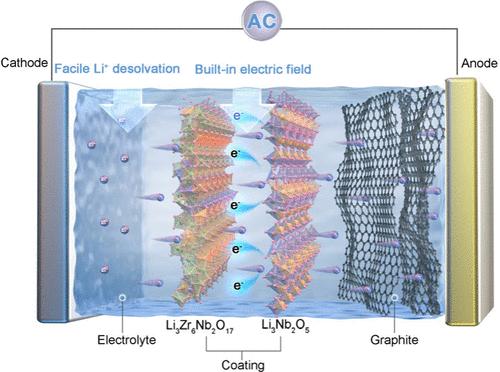Heterojunction-Coated Graphite Anode Enables Fast Charging via Built-In Electric Field-Regulated Interfacial Li-Ion Transport
IF 18.2
1区 材料科学
Q1 CHEMISTRY, PHYSICAL
引用次数: 0
Abstract
The sluggish Li-ion transport kinetics across anode interfaces remain a critical bottleneck limiting the fast-charging capability of lithium-ion batteries (LIBs). Herein, we design a lithiophilic Nb2O5/Zr6Nb2O17 (N/ZN) heterojunction to regulate the Li-ion transport behavior across the graphite anode interface. The tailored work function difference between Nb2O5 and Zr6Nb2O17 components establishes an internal built-in electric field that synergistically addresses the challenges: (i) accelerating interfacial Li ion (Li+) diffusion; (ii) optimizing Li intercalation/deintercalation kinetics; (iii) lowering the desolvation energy barrier. Therefore, the graphite anode with the N/ZN coating achieves 80.9% capacity retention at 6C-rate charging while effectively suppressing Li plating. This work demonstrates a heterojunction engineering strategy that concurrently enhances ionic transport and interfacial stability, offering a pathway for developing fast-charging anodes.

异质结涂层石墨阳极通过内置电场调节界面锂离子传输实现快速充电
锂离子在阳极界面上缓慢的输运动力学仍然是制约锂离子电池快速充电能力的关键瓶颈。在此,我们设计了一个亲锂Nb2O5/Zr6Nb2O17 (N/ZN)异质结来调节锂离子在石墨阳极界面上的输运行为。Nb2O5和Zr6Nb2O17组分之间定制的功函数差异建立了一个内部内置电场,协同解决以下挑战:(1)加速界面Li离子(Li+)扩散;(ii)优化锂嵌入/脱嵌动力学;(3)降低溶解能势垒。因此,镀有N/ZN涂层的石墨阳极在6c倍率充电时容量保持率达到80.9%,同时有效抑制了锂的镀。这项工作展示了一种异质结工程策略,同时增强了离子传输和界面稳定性,为开发快速充电阳极提供了途径。
本文章由计算机程序翻译,如有差异,请以英文原文为准。
求助全文
约1分钟内获得全文
求助全文
来源期刊

ACS Energy Letters
Energy-Renewable Energy, Sustainability and the Environment
CiteScore
31.20
自引率
5.00%
发文量
469
审稿时长
1 months
期刊介绍:
ACS Energy Letters is a monthly journal that publishes papers reporting new scientific advances in energy research. The journal focuses on topics that are of interest to scientists working in the fundamental and applied sciences. Rapid publication is a central criterion for acceptance, and the journal is known for its quick publication times, with an average of 4-6 weeks from submission to web publication in As Soon As Publishable format.
ACS Energy Letters is ranked as the number one journal in the Web of Science Electrochemistry category. It also ranks within the top 10 journals for Physical Chemistry, Energy & Fuels, and Nanoscience & Nanotechnology.
The journal offers several types of articles, including Letters, Energy Express, Perspectives, Reviews, Editorials, Viewpoints and Energy Focus. Additionally, authors have the option to submit videos that summarize or support the information presented in a Perspective or Review article, which can be highlighted on the journal's website. ACS Energy Letters is abstracted and indexed in Chemical Abstracts Service/SciFinder, EBSCO-summon, PubMed, Web of Science, Scopus and Portico.
 求助内容:
求助内容: 应助结果提醒方式:
应助结果提醒方式:


